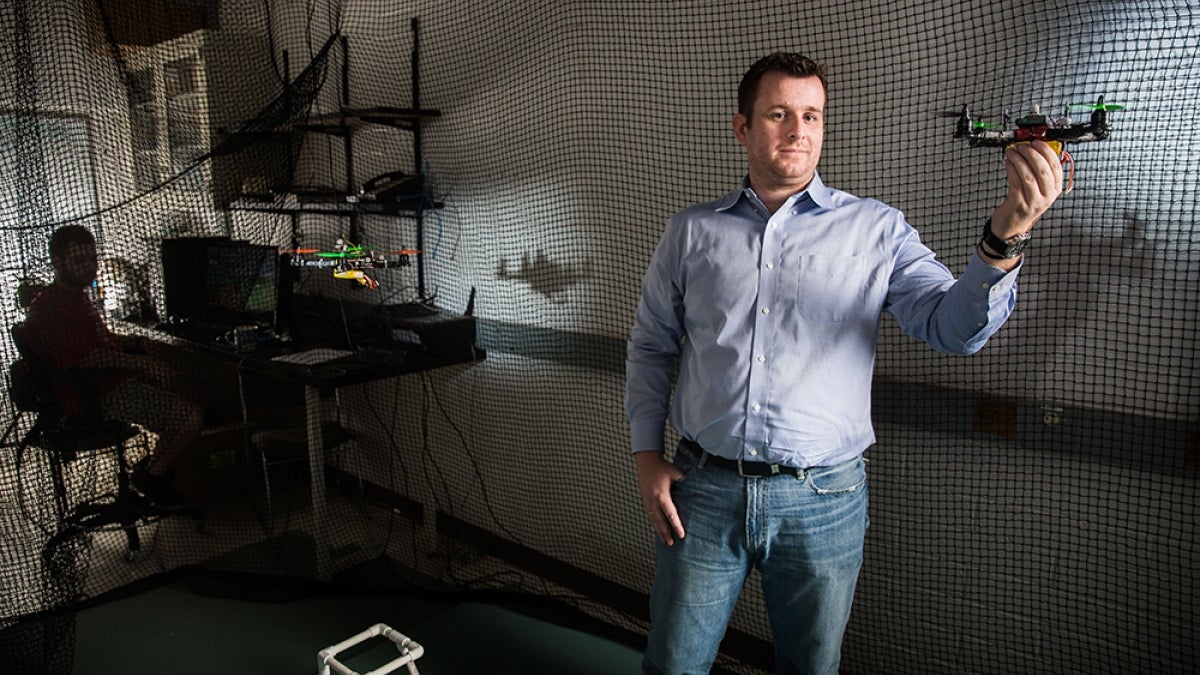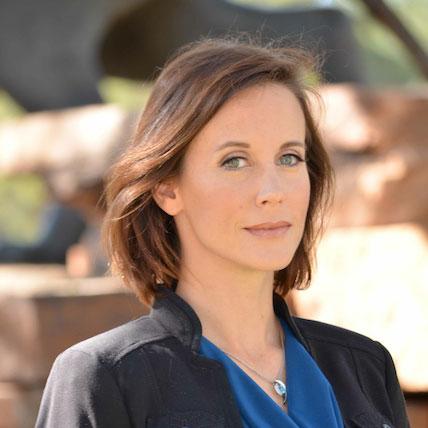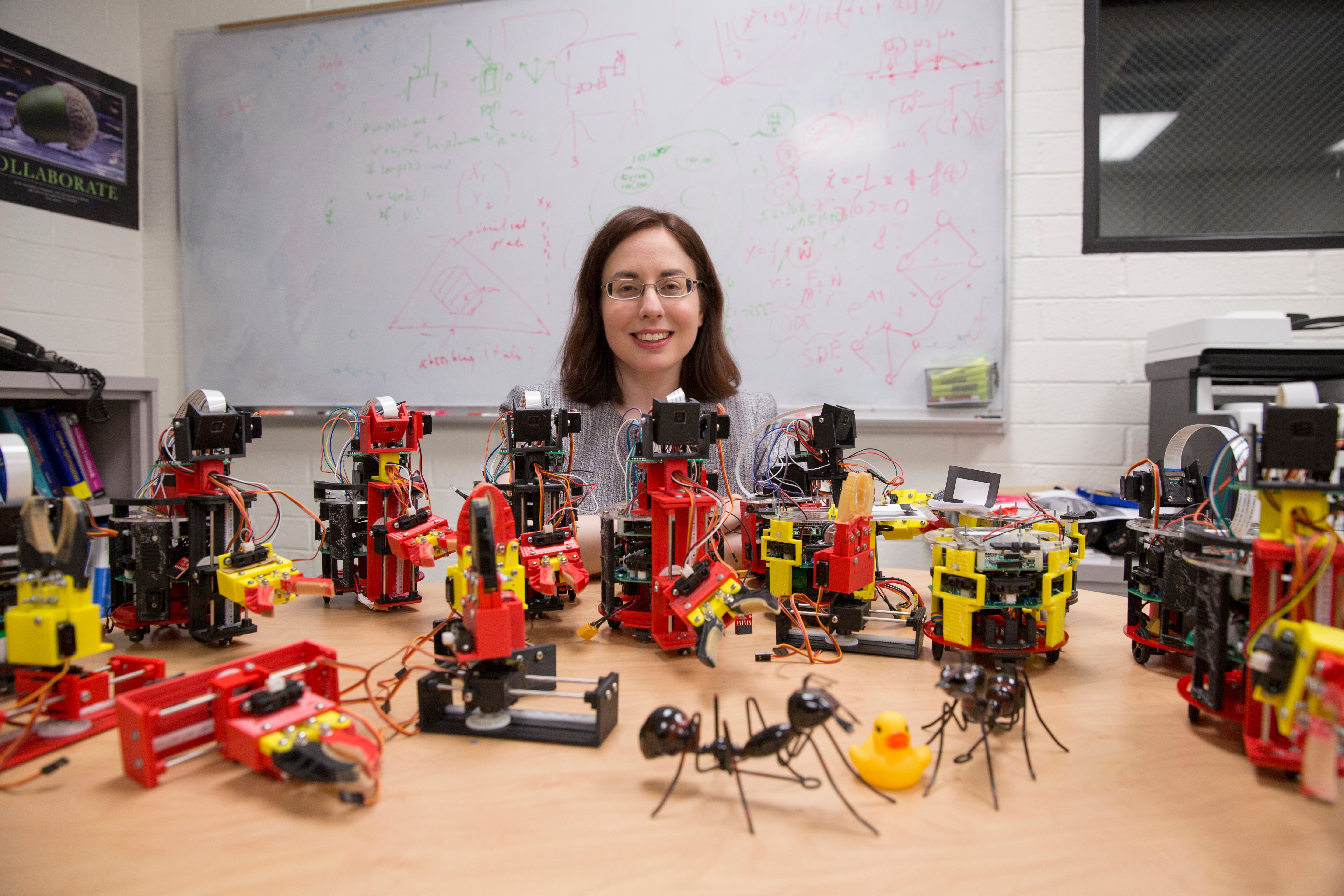During World War II, the government assembled the nation’s top scientists and tasked them with solving problems to win the war. The most famous result is the Manhattan Project, which created nuclear weapons on a windswept plateau in New Mexico.
Fast forward to the late 1950s. The Soviets launched Sputnik, catching the U.S. flat-footed. The government decided that couldn’t happen again. In response, Eisenhower created the Advanced Research Projects Agency. The object: to create and prevent strategic surprise.
In the years since, the agency has created the internet, GPS, drones and stealth technologies, among many other innovations that have trickled down to domestic use. Now called the Defense Advanced Research Projects Agency, it's the American version of James Bond’s Q branch.
The concept is called managed research, and Arizona State University has leveraged it as well as anybody. Faculty members are working on 23 DARPA projects. Six faculty in the past three years have won the DARPA Young Faculty Awards, bestowed on rising research stars in junior faculty positions at universities. ASU is eighth out of 115 universities — MIT is No. 1, with ASU coming in ahead of such institutions as Columbia and University of California-Berkeley — with the number of awards.
DARPA projects at ASU include a brain-drone swarm control interface created by Panagiotis Artemiadis (pictured above), an assistant professor of mechanical and aerospace engineering. Engineering professor Tom Sugar has created five wearable exo suits, including a jet pack that helps wearers run faster. Spring Berman, an assistant professor of mechanical and aerospace engineering, is working on a way for average people to tell a robot insect swarm to perform a task in unpredictable environments where comms and GPS don’t work well.
An ASU student demonstrates his speed using the jet pack from professor Tom Sugar’s Robotics Lab on the Polytechnic campus. The jet pack is designed to allow a person to run much faster for a relatively short period of time. Sugar concentrates on wearable robotics to enhance the person’s mobility, many projects of which are DARPA-related. Photo by Charlie Leight/ASU Now
DARPA operates on tight timelines, towards tightly defined goalsCurrent projects include exoskeletons for humans to carry heavy loads, a system to store payloads on the ocean floor and retrieve them when necessary, an air-launched hypersonic boost glide missile, and a robot like an earthworm.. They basically hire expert scientists to solve specific problems. If projects don’t pan out, they get canned.
The method is spreading across government and industry, including tech giants. Google has ATAP, the Advanced Technology and Projects group. Facebook has created Building 8, a similar tech incubator. (ASU in December announced it is partnering with Facebook to supply brainpower to the Building 8 project.)
Jamie Winterton is director of strategy for the Global Security Initiative, ASU’s primary interface to the Department of Defense and the intelligence community. She also chairs the university's DARPA Working Group, matching researchers with projects and shepherding them through the application process.
DARPA is high-risk, high-reward, Winterton said. “They’re not afraid of failure like a lot of the other government agencies or industry would be,” she said.
Managed research at ASU
“Sponsored research,” as it is dubbed at ASU, is an external entity with goals a university researcher is a likely candidate to solve. The client compensates the scientist to do the research. It has to be a realistic goal, with a good chance of completing the work in the allotted time frame.
Jamie Winterton
“Managed research is a good way to get money and time for things we might not be able to do on our own,” Winterton said. “Sometimes it works. Sometimes it doesn’t work. Fundamentally you have to have a good match between the sponsor and the researchers. You have to have the same goal. If the sponsor’s goal is, ‘We want to make 50 percent more widgets,’ that’s not a good match for university researchers. That’s not the kind of basic research we do here.”
Dan Bliss, an associate professor in the School of Electrical, Computer and Energy Engineering, studies wireless communications, including how radio and radar can work together. He is a managed research veteran, involved with three DARPA projects and a recently completed Google ATAP project.
Managed research “is really, really effective,” Bliss said. “It’s very good at technology developments. It’s very good at getting you from ‘Gee, we need to solve this problem,’ to actually getting it done. It’s not as good at solving the problem of ‘What’s out there?’ Basic science is often about fumbling around, so it doesn’t necessarily work as well for that.”
Daniel Sarewitz, professor of science and society in the School for the Future of Innovation in Society and co-director and co-founder of the Consortium for Science, Policy, and Outcomes, published an article in The New Atlantis in August about managed research.
He cited digital computers, jet aircraft, cellphones, the internet, lasers, satellites, GPS, digital imagery, nuclear and solar power, all of which came not from “the free play of free intellects,” but from the leashing of scientific creativity to the technological needs of the U.S. Department of Defense.
Of the 13 technological advances essential to the development of the iPhone, 11 — including the microprocessor, GPS and the internet — can be traced back to military research investments.
Managed research is not telling scientists how to do their science, however.
“I think there’s a continuum,” Sarewitz said. “What I really have in mind and was trying to explain in the article is the key point of managed research is accountability to end users for the work that’s being done.”
Government agencies outside of Defense are copying the DARPA model. Intelligence has IARPA. The Department of Energy has EARPA. It’s no accident tech is turning to the model.
“People have recognized how effective it is as a research organization and have tried to mimic in both inside the government and in the corporate environment,” Bliss said.
Fundamental research
Tech giants are seeing things they can do that rely on fundamental research, the kind that universities are really good at, Winterton said.
“It would be cost-prohibitive, even for one of the big tech companies, to retain all these people to work on projects that may or may not come to fruition,” Winterton said. “So they come to us.
Facebook and Google are recognizing they need to get things done, Sarewitz said. Traditionally, the world has George Washington Carver expectations of science. Shut the scientist alone in their lab, and they will produce solutions.
Sometimes it works, but for the most part, Sarewitz says, it’s “a beautiful lie.”
“Historically, we know it’s not true,” he said. “When you leave science alone, there’s no way to hold it accountable.”
The high risk and tight timelines aren’t applicable to all science.
“If we only had the DARPA model, that wouldn’t be a good thing,” Sarewtiz said. “You want some ability for scientists to not make quick progress. It’s an irony in the academic system that the pressure to publish so fast has the worst incentives of all, because productivity is justified only by more productivity. In the service of what?”
ASU engineer Spring Berman's work includes developing robotic technology to perform security surveillance, search-and-rescue missions, and detection of chemical, biological and nuclear materials — supported by a grant from DARPA. Photo by Jessica Hochreiter/ASU
The pressure can be intense to produce, Bliss said. He recalled working on a Google ATAP project.
“It was like trying to do six years of research in two years,” Bliss said. “We accomplished a lot, but it was a little stressful. We had program reviews every two months. It was intense.” He laughed.
“The model is aggressive, and it makes a professor like me a little crazy,” he said. “In a perfect world, I have a four-year grant I can sign up to, and I can hire a grad student and fund them, and I’m stable and I have no one looking over my shoulder. The problem with the DARPA model is that the program manager basically has to resell the program every year to their boss. If things aren’t going well, they’ll kill the program. There is a lot of pressure.”
Bliss has two reasons why managed research is becoming more widespread: It works, and corporate research labs have been cut.
“It seems like over the last 20 years there has been a de-emphasis on the corporate research lab,” Bliss said. “As a consequence, they need to bring in technologies from the outside, because they’re not building them as quickly on the inside.”
You either buy into small companies, or you go to universities and ask them to be a little bit more applied, and they do your research, Bliss said.
“You can see how you take a little bit of the DARPA model, which is very problem-centric, and you bring it into companies, and you do that,” he said. “Google and Facebook have both done this. Other organizations in different ways have done this.”
Bliss anticipates the model spreading. He pointed to former DARPA director Regina Dugan moving from Motorola to Google to Facebook. (“Celebrate impatience,” Dugan said at Google.)
“She champions this sort of approach, and for a lot of applications it works really well,” Bliss said.
We wouldn’t want all science to be like that, Sarewitz said.
“It’s important to keep in mind all public science is justified in trying to achieve something or another,” he said. “But you can do science that’s both patient and accountable to the end user. … The story I want to tell is that this is an empowering thing for science. It will make science better.”
Top photo: ASU assistant professor of mechanical and aerospace engineering Panagiotis Artemiadis, shown with drones from his laboratory, is the director of the Human-Oriented Robotics and Control Lab at ASU's Tempe campus. He has created a brain-drone swarm control interface. Photo by Deanna Dent/ASU Now
More Science and technology

Ancient sea creatures offer fresh insights into cancer
Sponges are among the oldest animals on Earth, dating back at least 600 million years. Comprising thousands of species, some with lifespans of up to 10,000 years, they are a biological enigma.…

When is a tomato more than a tomato? Crow guides class to a wider view of technology
How is a tomato a type of technology?Arizona State University President Michael Crow stood in front of a classroom full of students, holding up a tomato.“This object does not exist in nature,” he…

Student exploring how AI can assist people with vision loss
Partial vision loss can make life challenging for more than 6 million Americans. People with visual disabilities that can’t be remedied with glasses or contacts can sometimes struggle to safely…



